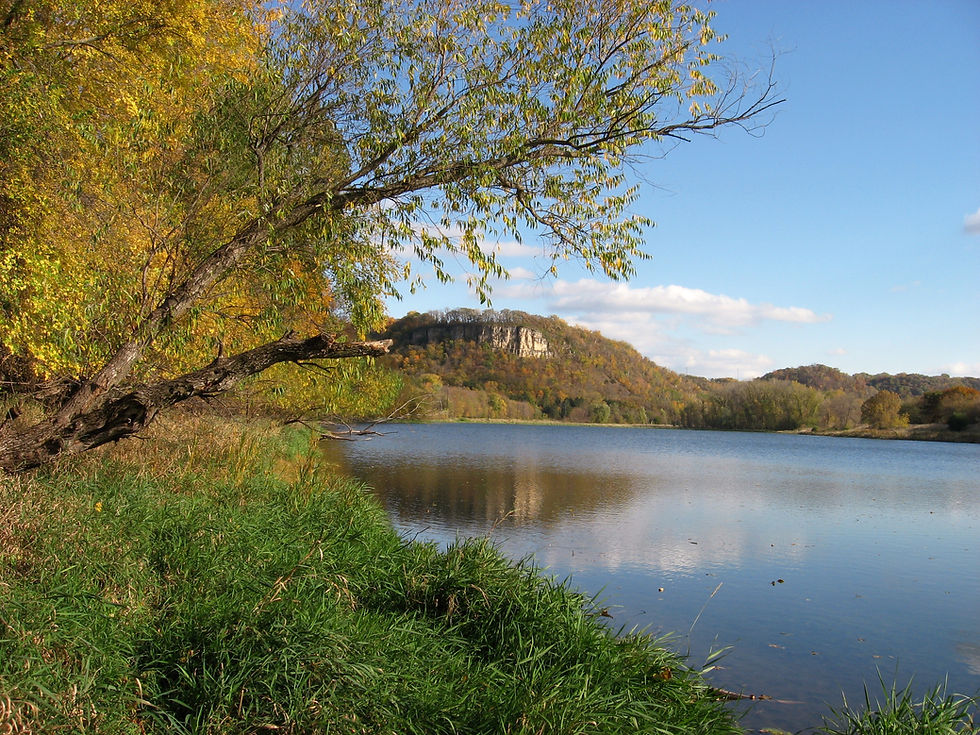Rattlesnake Bluff, Wacouta Prairie and Bay
- wacoutanaturenotes
- Aug 22, 2020
- 3 min read

Rattlesnake Bluff in Summer
Without a doubt, the most recognizable land feature in Wacouta Township is Rattlesnake Bluff. Here are a few points of interest about this landmark.
It is located 44 degrees north latitude and 92 degrees west longitude. The Bluff received its name from local residents who observed timber rattlesnakes up to 4 feet long moving from the bluff down to the river during periods of hot summer weather.
Many years ago, active rattlesnake dens were located on the upper reaches of the south facing bluff. One of the main reasons for the decline in rattlesnakes was the bounties paid in southeast Minnesota until 1989. In fact, in the 1940's nearly 6000 rattlesnakes were turned in for bounties in Houston County alone.

Rattlesnake Bluff in the Fall
The bluff top is 350 feet above the river and is 1500 feet above sea level. Some 10,000 years ago, melt water from the glaciers carved a deep channel in this area. Rattlesnake Bluff became an island in the 5 mile wide river spreading across the valley.
The gray upper part of the bluff is composed of Oneota dolomite from 450 million years ago. The lower yellow/orange rock is Jordan sandstone, one of the most easily recognized rock strata along this section of the river dating back 510 million years ago.

Peregrine Falcon Eyases Photo Courtesy of Jackie Fallon of the Midwest Peregrine Society.
Prior to the 1950's, nesting sites were common in the cliffs along the Mississippi River including Rattlesnake Bluff. With the widespread use of DDT, falcon populations were decimated. In the early 1970's DDT was banned and falcon numbers have rebounded.
In recent years, peregrine falcon nesting success has been very low due to predation by great horned owls. These young falcons from a successful nesting in 2010 have been the exception.

Spotted Horsemint
In a recent visit with Haley Golz, Project Coordinator of the Minnesota Land Trust for the Wacouta Prairie Restoration, I learned that they are very pleased with the excellent germination of prairie flora this spring. Because of that, the restoration is well ahead of schedule.
One of the prairie forbs showing up now is Spotted Horsemint (Monarda punctata). These interesting plants thrive in sandy soil conditions.

Blue Giant Hyssop
Another forb showing up in August is Blue Giant Hyssop (Agastache foeniculum).
It is one of the most ornamental of our prairie mints. This perennial has oval coarsely toothed leaves which give off a scent of anise when bruised.

Mowed Strips
The first part of August limited strips of prairie were mowed adjacent to wooded sections to reduce the likelihood of encroachment by woodland species such as sumac and box elder in the prairie.

Killdeer
Early in the morning of August 12th with the river level at 3.7 feet, I decided to paddle my canoe up into Wacouta Bay. Compared to the high water levels in the summer of 2019, this summer is more normal.
Because of the lower levels, several mudflats were exposed and available for shorebirds to search for food. In recent years, the most common shorebirds observed were spotted and solitary sandpipers.
Even though I have observed numerous killdeer along the river banks of the Cannon and Zumbro Rivers, seldom have I seen them in Wacouta Bay. This morning was the exception.
Prime habitat for killdeer is open areas such as sandbars, mudflats and grazed fields. These birds are well known practitioners of a broken-wing display in an attempt to lure predators away from their nest.

Young Raccoons
As I was paddling my canoe along the north side of the bay, I observed an unusual sight in the distance. At first, I thought it might be a pair of river otters. I soon realized it was a family of young raccoons out on a morning breakfast patrol.

Two Raccoons Feeding
It wasn't until I was within 40 yards and my camera on full zoom that I could determine what they were eating. Because of the low water levels these omnivores were feasting on the newly exposed succulent aquatic vegetation. I later determined they were eating the leaves of the smartweed plant.




These were the cute little raccoons that you referred to awhile back - they were darling!